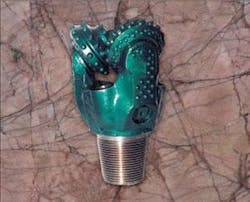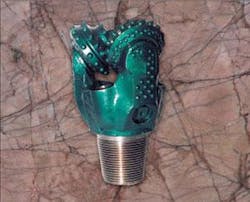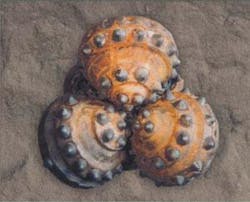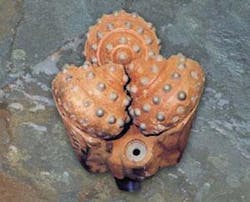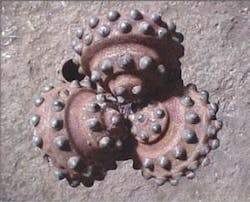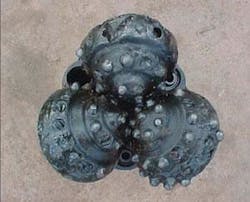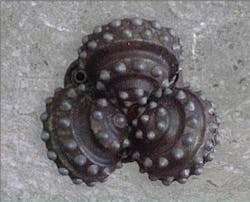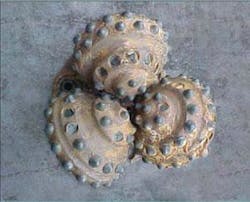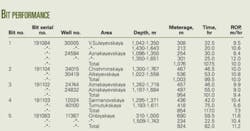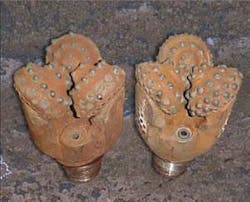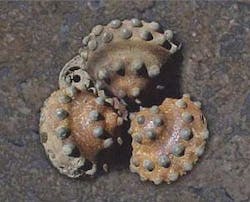The calculation method proposed in this series, using actual gear ratio for the cones, allows the designer to determine and optimize kinematic parameters of drill bits. The analysis is applicable to both steel tooth and tungsten carbide insert bits.1 2 3 4
This final part of this four-part series will discuss the performance of a modified roller cone bit in the Tatneft OSC oil fields as compared with other bits.
Earlier parts of this series covered roller cone bit design analysis with teeth of equal and varied pitch, and the interaction of bits with the well bottom during pure rolling.
Slip value
It is possible to increase the cone cutters’ slip value for soft-formation bits and to decrease this value to a minimum for hard, abrasive formation bits, and even to create a true rolling rock bit, in which cone cutter elements interact with the hole bottom without any slip.
The results of the work presented in this series can be used to design and optimize roller cone bits and analyze their performance under different drilling conditions.
This article reviews the performance of one of the jet roller cone bit models tested in Russia. The Challenger-type, 8½-in. CH55MRS bit (IADC code 637Y), with sealed oil-filled bearings, was designed to drill hard, abrasive formations. Tatneft Open Stock Co. (OSC) tested the bit (Fig. 1) widely in several different oil fields.5
Bit design
The 8½-in. CH55MRS bit cutting structure consists of hard-alloy hemispherical heel teeth combined with tapered teeth of the second rows. The outer end of the cones is reinforced with two rows of hard-alloy hemispherical teeth. The bit legs are protected by hard-facing on shirttail and the leading edges and by rows of hemispherical tungsten carbide inserts that act as roller gaugers. The sealed oil-filled journal bearing of the bit comprises silver-plated floating elements. The recommended WOB is in the range of 13-23 tonnes at 50-250 rpm.
The design of the 8½-in. CH55MRS bit was motivated by test results from an 8½-in. ETD55-type bit (IADC code 637Y) conducted in 2002 by the Almetyevskoye drilling department of Tatneft OSC. Although test results were positive (715 m in 65.1 hr at ROP 11 m/hr), engineers observed premature wear of the cone heel rows while the bit bearing remained in operable condition (Fig. 2).
This wear pattern during drilling of hard abrasive formations such as experienced in Tatarstan is common among roller cone bits. Fig. 3 shows a dull bit from another manufacturer after drilling 539 m in 48.7 hr at ROP 11.1 m/hr in the Berezovskoye field by Tatneft’s Almetyevskoye drilling department.
Having reinforced the cone gauge part of the bit, according to Equation 53 cited earlier in Part 3 (OGJ, Feb. 25, 2008, p. 40), a US-based drill bit manufacturer developed the 8½-in. CH55MRS type bit design, which was tested by Tatneft’s Almetyevskoye and Aznakayevskoye drilling departments in June-December 2003.
Test sites, horizons
Fifteen 8½-in. CH55MRS bits were used to drill directional wells in a Devonian section (from Upper Carbon to the Pashiysky horizon) in 13 Russian fields: Abdrakhmanovskoye, Onbiyskoye, Zay-Karatayskoye, Minibayevskoye, Novo-Yelkhovskoye, T-Kandizskoye, Aznakayevskoye, Sarmanovskoye, Alkeyevskoye, Chishminskoye, Leninogorskoye, Vostochno-Suleyevskoye, and Tumutukskoye.
The bits were tested while drilling the 310-2,030-m thick section in all stratigraphic horizons ranging from the surface casing to total depth. The stratigraphic horizons included the Upper Carbon, Myachkovsky, Podolsky, Kashirsky, Vereysky, Bashkirsky, Namyursky, Serpukhovsko-Oksky, Tulsky, Carboniferous, Turneysky, Verkhnefamensky, Nizhnefamensky, Verkhnefransky, Mendimsky, Domanikovy, Shugurovsky, Kinovsky, and Pashiysky.
For the most part, the geological profile includes tight and hard, abrasive limestones and dolomites, except for the Vereysky, Carboniferous, Kynovsky, and Pashiysky horizons that include argillites, siltstones, and sandstones.
Equipment
Tatneft drilled 24 wells using the БУ-75-БрЭ drilling rig, БРН-1 mud pumps, and four downhole motors:
- Д5-172M (100-110 rpm).
- Д2-195 (100-110 rpm).
- ДВ-172 (200-240 rpm).
- ДВ-176 (200-240 rpm).
Process water was used for the drilling fluid and rotary drilling with clay mud system was used in four wells.
The bottomhole assembly (BHA) included:
- 8½-in. CH55MRS bit with three 12.7-mm jet nozzles.
- Positive-displacement motor (PDM).
- Float collar and 165 mm × 100 m drill collars.
- 127 × 9.3 mm ТБПК drill pipes.
The drilling parameters included:
- WOB = 12-17 tonnes.
- Circulation rate when drilling with PDM = 30 l./sec. (1,000 l./min.), when drilling in rotary mode = 15 l./sec. (900 l./min).
- Rotary speed when drilling with PDM = 100-240 rpm, when drilling in rotary mode = 65 rpm.
- Manifold pressure = 8-10 MPa, when drilling in rotary mode = 4-5 MPa.
Operations
One advantage of drilling with the 8½-in. CH55MRS-type bits was the opportunity to reuse. Among the 15 used bits, only four were worn out in a single run in one of the wells. In two successive wells, ten 8½-in. CH55MRS bits were run twice. Also, bit No. 191083 was used twice in well No. 11367 in the Onbiyskaya area to drill the depth intervals 310-1,000 m and 1,509-1,743 m. In total, the bit drilled 924 m in 82 hr, at an ROP of 11.3 m/hr.
As a rule, after the first bit run (drilling about 400-600 m in 30-60 hr), the 8½-in. CH55MRS-type bits remained practically unworn and were reused, achieving 800-1,000 m per bit.
Fig. 4 shows the 8½-in. CH55MRS bit No. 191084 after making 521 m of hole in 52.5 hr in well No 30005 in the Vostochno-Suleyevskaya area. Fig. 5 shows the same bit after its second run in the well No. 24594 in the Aznakayevskaya area where it drilled 555 m in 55 hr. In total, this bit penetrated 1,076 m in 107.5 hr at an average ROP of 10 m/hr.
Fig. 6 shows the 8½-in. CH55MRS bit, No. 191103 after it drilled 436 m of hole in 42 hr in well No. 12024 in the Sarmanovskaya area. The same bit appears in Fig. 7 after its second run in exploratory well No. 40100 in the Tumutukskaya area, where it made an extra 418 m of hole in 75 hr.
In total, the bit penetrated 854 m of hole in 117 hr in two runs at an average ROP 7.3 m/hr. It should be taken into account that during the second run of the bit in well No. 40100, the drilling fluid was a natural water suspension that contained formation fluids including hydrogen sulfide.
The test results show that the average depth drilled by each 8½-in. CH55MRS-type bit was 757 m during an average drilling period of 95.8 hr. The average ROP was 7.9 m/hr.
The 8½-in. CH55MRS-type bits performed well when drilling both with low and high-speed downhole motors.
Also, it is important to note that drilling with the 8½-in. CH55MRS bits was preceded by first drilling out the 70-120-m thick cement plug in each well. During reuse of the bit, the total thickness of the drilled-out cement was 300 m.
Wear performance
Examination of the used bits confirmed that three of them had failed due to bearing wear and the other 12 bits failed due to cutting structure wear. This suggests that in order to improve the performance of the 8½-in. CH55MRS bits it would be necessary to optimize the BHA and the drilling fluid’s circulation rate. This would adjust the energy characteristics of the downhole motors to the operational resource of the bit.
Table 1 shows the typical performance data of five 8½-in. CH55MRS bits.
Tatneft’s Aznakayevskoye drilling department ran the first four bits using the Д5-172 downhole motor at 100-110 rpm. The first bit, No. 191084, was run through the last depth interval, 1,350-1,651 m, using the ДB-172 high-speed positive displacement downhole motor at speeds reaching 240 rpm.
The fifth bit, No. 191083, was run in the Almetyevskoye drilling department area with the ДB-176 high-speed positive displacement downhole motor at speeds reaching 240 rpm.
The bearings of all five bits remained fully operable.
The gauge loss of the tested bits was as follows:
- No. 1910843 mm after making 1,076 m of hole and 800,000 revolutions.
- No. 1911040.5 mm after 1,003 m of hole and 600,000 revolutions.
- No. 1911021 mm after 954 m of hole and 600,000 revolutions.
- No. 1911031 mm after 854 m of hole and 700,000 revolutions.
- No. 1910832 mm after 924 m of hole and 1,100,000 revolutions.
Comparisons
Fig. 8 shows two bits used to drill in the Aznakayevskoye drilling department area. At left, the 8½-in. CH55MRS bit No. 191103 after making 854 m of hole in 117 hr and a corresponding bit produced by a different manufacturer, with diamond inserts at the outer end of the cones, at right, after drilling 868 m in 82.2 at an average ROP of 10.5 m/hr.
Despite the diamond protection of the bit cone gauge, the gauge loss of the bit shown at right was 7 mm while that of bit No. 191103 (at left) was only 1 mm.
Another comparison in Fig. 9 shows two bits used the Almetyevskaya drilling department area. The 8½-in. CH55MRS bit No. 191083 is shown at right after making 690 m of hole in 59.5 hr at ROP 11.6 m/hr using a high-speed positive displacement downhole motor (240 rpm). The bit at left, produced by another manufacturer, drilled 592 m in 52 hr in the same area at ROP 11.4 m/hr using a low-speed downhole motor (100 rpm).
Note that bit No. 191083 was used to make additional hole with a high-speed positive displacement downhole motor (240 rpm) and drilled, in total, 924 m in 82 hr at an average ROP 11.2 m/hr.
Successful test results with the 8½-in. CH55MRS bits in the Almetyevskaya and Aznakayevskaya drilling department areas contributed to Tatneft’s decision to use these bits across a wide number of fields.5
Currently, Tatneft uses these bits to drill directional and horizontal wells with positive-displacement downhole motors and geared turbodrills (type ТРШ-195).
The 8½-in. CH55MRS bit No. 196982 is an example of drilling consecutive wells with a high-speed downhole motor (ДB-172) and a geared turbodrill (ТРШ-195). This bit was used in three runs in well No. 2410 in the Iskrinskaya area of the Aznakayevskoye drilling department and drilled 1,017 m in 142 hr at an average ROP 7.2 m/hr:
- Hole section 387-646 m; 259 m in 31.5 hr at ROP 8.2 m/hr; ТРШ-195.
- Hole section 646-687 m; 41 m in 8 hr at ROP 5.1 m/hr; ДB-172.
- Hole section 687-1,404 m; 717 m in 102.5 hr at ROP 7 m/hr; ТРШ-195.
Fig. 10 shows the wear of the cutting structure of the 8½-in. CH55MRS bit No. 196982. The bit gauge loss was in the range of 1 mm. The bearing remained in operable condition.
Based on the successful tests and high performance, Tatneft OSC bought 500 8½-in. CH55MRS-type bits in 2004. To date, these roller cone bits have been successfully used in the Russian Republics of Bashkortostan, Komi, Udmurtia, Karelia and in the Orenburg region.
Kinematic design results
- Analytical and experimental studies confirm that the actual gear ratio ia for the three-cone bit cones with equally-pitched heel rows may have values shown in Equations 1-5.
- Analytical and experimental studies confirm that the actual gear ratio iak for the three-cone bit cones with varying pitch of the heel rows is determined by the relationships shown in Equations 6 and 7.
- The cones of the 21B-151T bit with equal pitch of the heel teeth which is determined by the relationship iZ/k = N (where N the integer, k the number of bit cones) destroy the well bottom when drilling hard abrasive rock in the mode of pure rolling of their heel rows and provide a two-fold increase in depth drilled as compared to the base commercial bit.
- The 8½-in. CH55MRS-type roller cone bits (IADC code 637Y) are highly efficient in drilling hard abrasive formations when used with low and high-speed positive-displacement downhole motors and geared turbodrills.
- The average depth drilled by each 8½-in. CH55MRS bit in the Tatneft OSC drilling areas was 757 m. Some 8½-in. CH55MRS bits achieved meterage in excess of 1,000 m, suggesting that the analysis used to optimize this bit design was successful.
References
- Palashchenko,Y.A., “Technique of calculation of kinematic parameters for combined roller cone bit,” Proceedings of Conference on Dynamics and Durability of Oil Equipment, Baku, AZINEFTECHIM, 1974.
- Palashchenko,Y.A., “Technique of calculation of kinematic parameters for rock drill bits without offset of cones,” News of Universities, Geology and Exploration, Moscow, VINITI, 1981.
- Palaschenko, Yuri, “Rock bits with the optimal kinematics,” Sixth International Symposium on the Observation of the Continental Crust Through Drilling, International Lithosphere program,, Continental Scientific Drilling Program, Paris, Apr. 7-10, 1992.
- Palaschenko, Y.A., “Influence of rock bit kinematics on the bottom hole destruction process,” poster session abstracts, First North American Rock Mechanics Symposium, the University of Texas at Austin, June 2, 1994.
- Vakula, A., Bikchurin, T., Bikbulatov, R., Schreiber, L., and Palashchenko, Y., “1,000 m of hole and more drilled with a single Varel roller cone bit in the Tatneft OSC oil fields,” Drilling and Oil magazine, June 2004, pp. 12-14.
